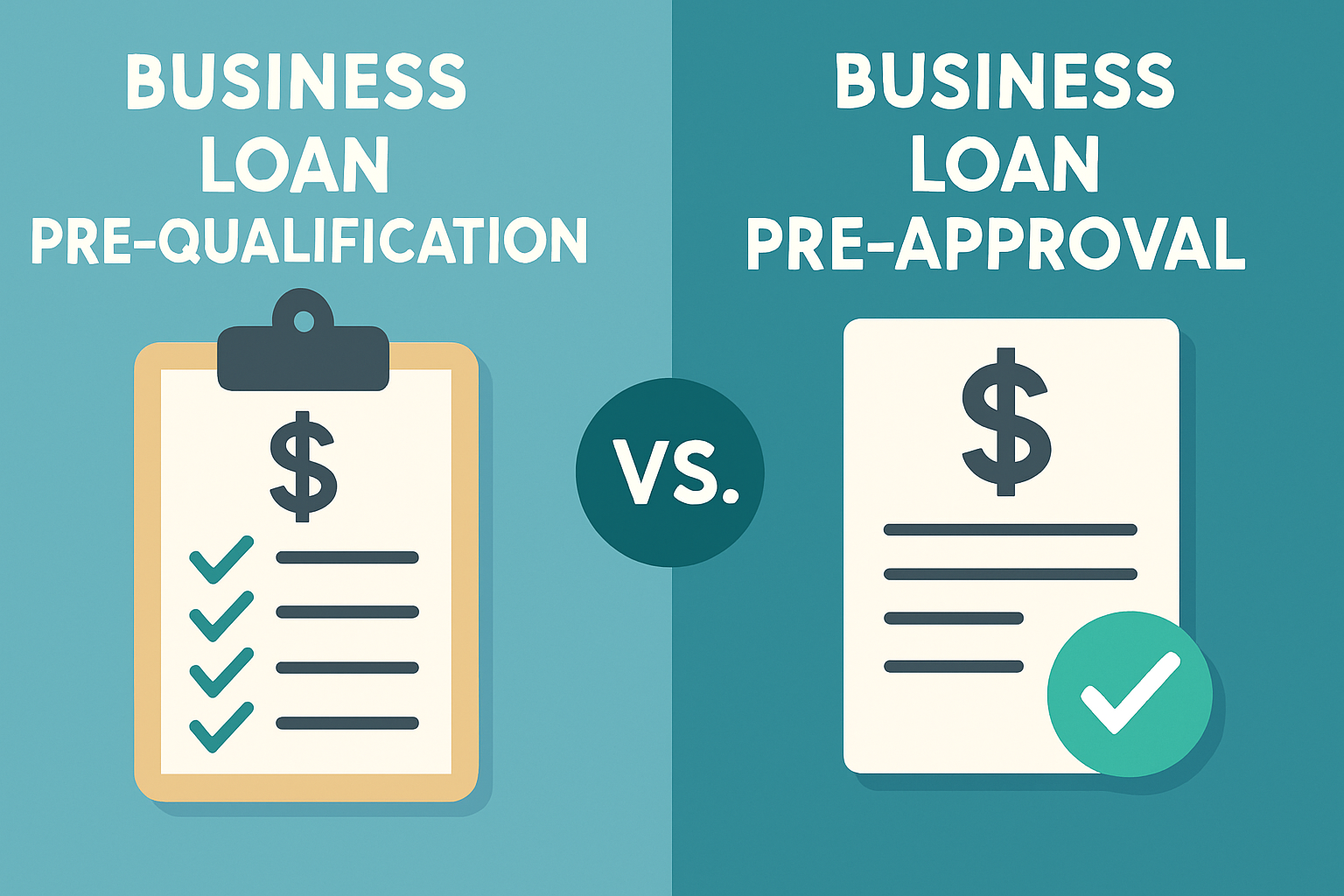Business Loan Pre-Qualification vs. Pre-Approval: What’s the Difference?
When you’re looking for a small business loan, you’ll likely see two similar terms pop up during the early stages: pre-qualification and pre-approval.
Both suggest that a lender is interested in working with you — but they don’t mean the same thing. Understanding the difference between pre-qualification and pre-approval can help you gauge how close you are to securing financing and how seriously a lender is taking your application.
This guide breaks down how each process works, what information lenders need, and which step brings you closer to funding.
What Is Business Loan Pre-Qualification?
Pre-qualification is the first step in the lending process. It’s a quick, often automated assessment based on basic information you provide about your business.
It helps lenders — and you — determine whether your business meets general eligibility requirements for a loan, but it’s not a guarantee of approval or loan terms.
Key features of pre-qualification:
-
Usually based on self-reported financial information (no hard credit pull)
-
Takes minutes to complete online or by phone
-
Provides an estimated loan amount, term, and rate range
-
Often uses a soft credit inquiry, which doesn’t affect your score
Think of it as an initial screening that tells both you and the lender if it’s worth moving forward.
Example: You enter your business’s revenue, time in operation, and estimated credit score into a lender’s website. The lender’s system responds: “You may qualify for up to $250,000 at rates starting at 9%.” That’s pre-qualification.
What Is Business Loan Pre-Approval?
Pre-approval is a more formal step. It involves submitting verified financial documents — such as bank statements, tax returns, or business financials — so the lender can perform a deeper analysis.
While still not final approval, pre-approval shows that you’ve passed the lender’s preliminary underwriting review and are a strong candidate for funding.
Key features of pre-approval:
-
Requires documentation and a more detailed application
-
May involve a hard credit inquiry
-
Provides conditional loan terms (amount, interest rate, repayment period)
-
Demonstrates serious intent to borrow
Once pre-approved, you’re typically one step away from full loan approval and funding — pending verification or additional documentation.
Pre-Qualification vs. Pre-Approval: Key Differences
| Feature | Pre-Qualification | Pre-Approval |
|---|---|---|
| Purpose | Early screening | Formal conditional offer |
| Credit Check | Soft inquiry (no impact) | Hard inquiry (may affect score) |
| Information Required | Basic business data (revenue, time in business) | Verified documents (tax returns, financials) |
| Speed | Instant or within hours | A few days to a week |
| Commitment Level | Low | Medium — lender more invested |
| Guarantee of Funding | None | Conditional, pending full approval |
Why These Steps Matter
Knowing where you stand in the process helps you make better financial decisions:
-
Pre-qualification helps you compare multiple lenders quickly.
-
Pre-approval positions you as a serious borrower ready for final approval.
-
Both help you understand loan eligibility and manage expectations before committing to an offer.
If you’re still exploring options, pre-qualification gives you a quick snapshot of what you can afford. But if you’re ready to move forward, pre-approval gets you closer to securing funds.
How to Move From Pre-Qualification to Pre-Approval (Featured Snippet Section)
-
Gather financial documents (tax returns, P&Ls, bank statements)
-
Improve your credit score if needed
-
Review loan options and select a lender
-
Submit a full loan application for underwriting
-
Receive conditional pre-approval and finalize details
What Lenders Look for During Pre-Approval
While pre-qualification focuses on estimated numbers, pre-approval digs into your actual financial performance. Expect lenders to evaluate:
-
Business credit score and payment history
-
Debt-to-income and cash flow ratios
-
Collateral and assets
-
Time in business and industry type
-
Purpose of the loan and repayment plan
A strong financial profile — especially consistent cash flow — can help you qualify for better rates and higher loan amounts.
Common Misconceptions
-
❌ “Pre-approval guarantees funding.”
Not true — lenders still need to verify final details before approval. -
❌ “Pre-qualification isn’t worth doing.”
It’s valuable for comparison shopping and checking eligibility without hurting your credit. -
❌ “I can skip both steps.”
Going straight to full application can waste time if you’re not eligible.
When to Use Each
Use pre-qualification when:
-
You’re exploring multiple lenders.
-
You want to estimate your borrowing power.
-
You’re not ready for a credit check.
Use pre-approval when:
-
You’ve chosen your preferred lender.
-
You’re ready to finalize loan terms.
-
You need funds soon and want a head start on underwriting.
Conclusion: Two Steps Toward One Goal
While pre-qualification gives you an overview of potential loan options, pre-approval moves you closer to the finish line. Together, they form a roadmap to securing funding efficiently — helping you save time, avoid surprises, and approach lenders with confidence.
The more prepared you are at each stage, the smoother the process — and the faster your business gets the funding it needs to grow.











